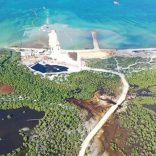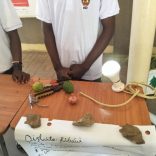Trump sets 50% U.S. tariffs on copper, Brazilian imports starting In August
Cabo Verde: Former concentration camp among eight sites seeking UNESCO status

Photo: Lusa
The former concentration camp of Tarrafal, on the island of Santiago, in Cabo Verde, is the first of eight sites that the country’s authorities have already identified as having the potential to be classified as UNESCO World Heritage, according to the government.
At a two-day seminar held on Tuesday and Wednesday in Praia to disseminate the tentative list of sites, the Ministry of Culture provided infornation identifying “set of assets that can be worked on and classified as World Heritage” by the United Nations Educational, Social and Cultural Organisatio.
These are the Natural Park of Cova, Paul and Ribeira da Torre (on Santo Antão), the Complex of Protected Areas of Santa Luzia and Ilhéus Branco and Raso, the Saltpans of Pedra de Lume (on Sal), the historic centres of Praia (on Santiago), São Filipe (on Fogo) and Nova Sintra (on Brava), the Natural Park of Chã das Caldeiras (on Fogo) and the former camp at Tarrafal.
“At this moment, the country has already set in motion the process for the elevation of the Tarrafal Concentration Camp in Santiago for its classification with UNESCO, in a joint work that brings together, besides national technicians, a cooperation already signed with Portugal,” explained the Ministry of Culture and Creative Industries of Cabo Verde, in a release seen o Wednesday by Lusa.
At the opening of the seminar, the minister of culture and president of the Cabo Verde UNESCO National Committee, Abraão Vicente, explained that the assets already identified “can be worked on and classified as World Heritage” in the future.
“We have assets classified as national heritage from Santo Antão to Brava,” he said. “We are now going to work hard to train our technicians and complete the dossiers, which is the part that Cabo Verde still has some difficulty with.”
Cape Verde and Portugal on 6 July signed a protocol on the protection and conservation of cultural heritage, with particular reference to Tarrafal, with a view to its being recognised by UNESCO.
The agreement was signed by Vicente for Cabo Verde and Portugal’s minister of culture, Graça Fonseca, during an official visit that the latter made to the archipelago, with the event taking place at the former camp, which is in the northern part of Santiago island.
The two countries thereby committed to cooperating for the protection, conservation, safeguarding and dissemination of cultural heritage, through training, technical capacity building, sharing of scientific content, publications, research, professional exchange and joint scientific activities.
The protocol also commits them to fostering the exchange of technicians, preparation of exhibitions, namely in the areas of material heritage (movable and immovable), immaterial heritage and museums, with special emphasis on the Museum of Resistance of Tarrafal Camp and the National Museum of Resistance and Freedom.
Fonseca, for her part, stressed the importance of the protocol in helping in the preparation of the bid to make the former concentration camp UNESCO World Heritage, alongside the work that Portugal’s government is doing at the fortress in Peniche, a former prison for opponents of the Salazar dictatorship.
“They are two places that have a history to tell,” she said. “We are sharing the work; we started in Portugal with the whole process of turning the Peniche Fortress into a museum, now the National Museum of Resistance, and [the agreement] is exactly with this objective, technical cooperation in the different areas.”
The cooperation is to take place between Portugal’s Directorate-General of Heritage and Cabo Verde’s Institute of Cultural Heritage (IPC), Fonseca explained, stressing that the two countries are thus showing that they have not forgotten the past and are building the future.
For his part, the Cabo Verde minister said that, after the rehabilitation of the camp, completed four months ago, the country had begun a new stage of preservation and enhancement of its collective memory and “has never been so close” to submitting an application for the former concentration camp to become a UNESCO World Heritage Site.
He said that the country aims to submit the formal bid at the next date made available by UNESCO, hoping that it will be next year.
Located in the town of Chão Bom, the former concentration camp of Tarrafal was built in 1936 and received its first 152 political prisoners on 29 October of the same year, operating until 1956. It reopened in 1962, under the name of ‘Chão Bom Labour Camp’, with the purpose of incarcerating anti-colonial activists from Angola, Guinea-Bissau and Cabo Verde.
In all, more than 500 people were imprisoned in what became known as a “slow death camp”: 340 anti-fascists and 230 anti-colonial activists.
After its deactivation, the complex functioned as a military training centre. Since 2000, it has housed the Resistance Museum.
The space was classified as National Cultural Heritage in 2004.












Leave a Reply
Be the First to Comment!
You must be logged in to post a comment.
You must be logged in to post a comment.